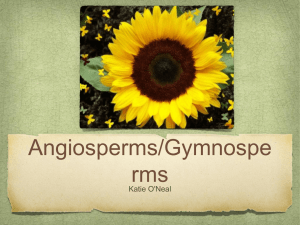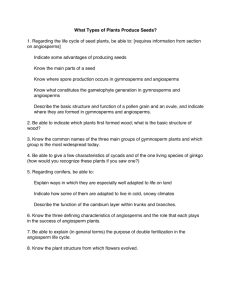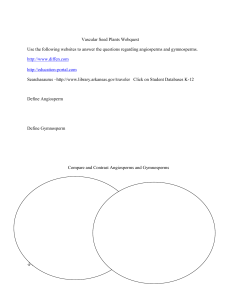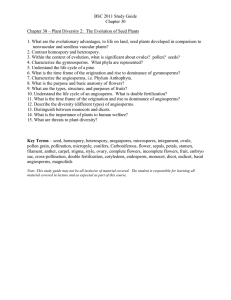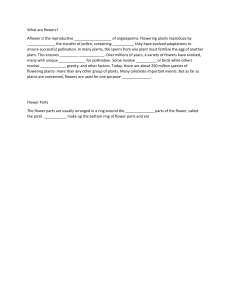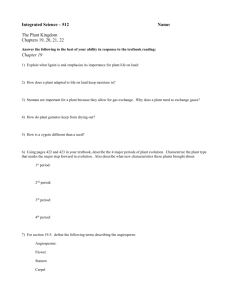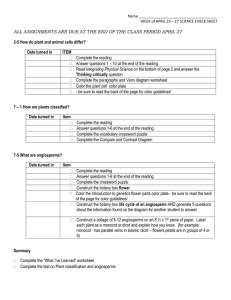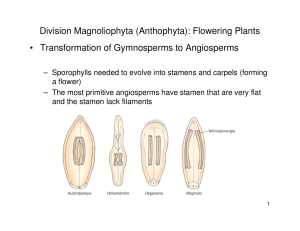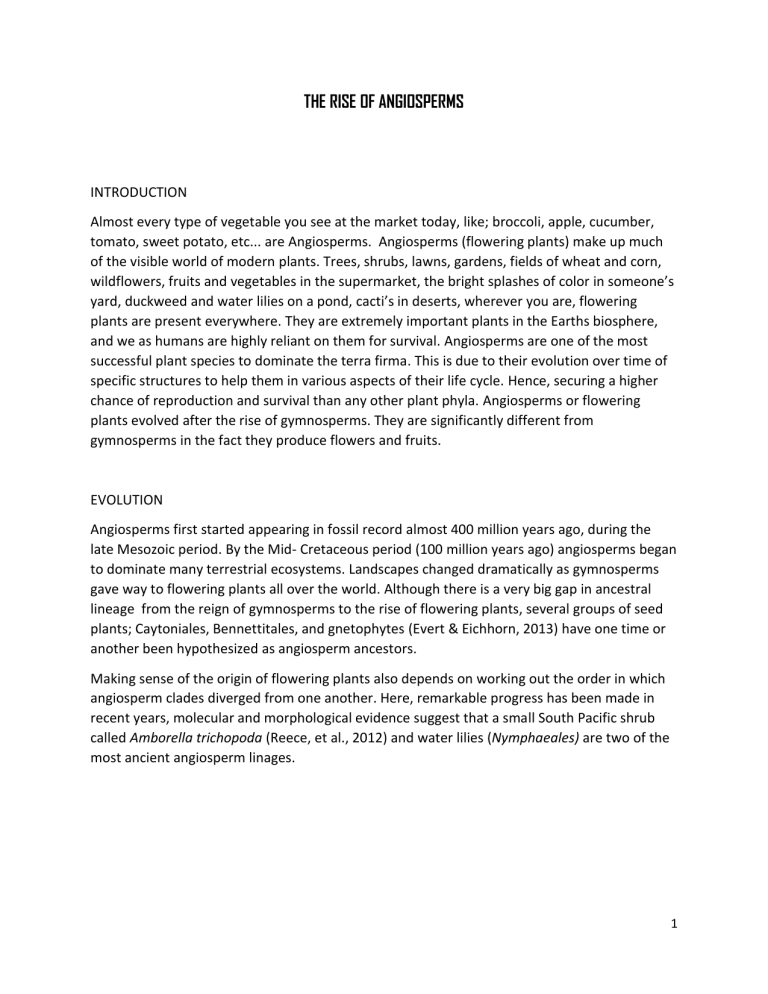
THE RISE OF ANGIOSPERMS INTRODUCTION Almost every type of vegetable you see at the market today, like; broccoli, apple, cucumber, tomato, sweet potato, etc... are Angiosperms. Angiosperms (flowering plants) make up much of the visible world of modern plants. Trees, shrubs, lawns, gardens, fields of wheat and corn, wildflowers, fruits and vegetables in the supermarket, the bright splashes of color in someone’s yard, duckweed and water lilies on a pond, cacti’s in deserts, wherever you are, flowering plants are present everywhere. They are extremely important plants in the Earths biosphere, and we as humans are highly reliant on them for survival. Angiosperms are one of the most successful plant species to dominate the terra firma. This is due to their evolution over time of specific structures to help them in various aspects of their life cycle. Hence, securing a higher chance of reproduction and survival than any other plant phyla. Angiosperms or flowering plants evolved after the rise of gymnosperms. They are significantly different from gymnosperms in the fact they produce flowers and fruits. EVOLUTION Angiosperms first started appearing in fossil record almost 400 million years ago, during the late Mesozoic period. By the Mid- Cretaceous period (100 million years ago) angiosperms began to dominate many terrestrial ecosystems. Landscapes changed dramatically as gymnosperms gave way to flowering plants all over the world. Although there is a very big gap in ancestral lineage from the reign of gymnosperms to the rise of flowering plants, several groups of seed plants; Caytoniales, Bennettitales, and gnetophytes (Evert & Eichhorn, 2013) have one time or another been hypothesized as angiosperm ancestors. Making sense of the origin of flowering plants also depends on working out the order in which angiosperm clades diverged from one another. Here, remarkable progress has been made in recent years, molecular and morphological evidence suggest that a small South Pacific shrub called Amborella trichopoda (Reece, et al., 2012) and water lilies (Nymphaeales) are two of the most ancient angiosperm linages. 1 Figure 1. Cladogram showing phylogenetic relationships of the angiosperms. The phylogenetic tree draws an easy to follow diagram, that basically attempts to show the complex evolution of ancient to modern flowering plants, from gymnosperms. The most ancient angiosperm lineages ( ANITA basal grade angiosperms) are placed above the rest of the flowering plants, the Mesangiosperms.The Mesangiosperms include the Chloranthales, Magnoliids, monocots, ceratophyllales, and eudicots. All angiosperms make up a single phylum, Anthophyta, which includes possibly as many as 450,000 species, and is by far, the largest phylum of photosynthetic species. Angiosperms share so many unique features that it is clear that they are monophyletic (come from a single common ancestor). They comprise of two very large classes, the Monocotyledonae (monocots), with at least 90,000 species, and Eudicotyledonae (eudicots), with at least 200,000 species. (Evert & Eichhorn, 2013). CHARACTERISTICS Angiosperms evolved over time certain characteristic that facilitated them in their prosperity. The most important and significant features that they established was their ability to produce flowers and fruits. These features separate them from all other previous plant organism, and also is the fundamental reason behind their worldwide supremacy. Flower Most angiosperms can reproduce sexually, although some can reproduce asexually or both. The flower is a unique angiosperm structure specialized for sexual reproduction, it is a determinate shoot that bears sporophyll (sporangium bearing leaves). Many flowers have four rings of modified leaves (sporophylls) called floral organs. The floral organs include two sets of sterile attachments, the sepals and petals, and two sets of fertile parts, the stamens (produces male gametophyte) and carpels (manufactures female gametophytes). The modified sporophylls of the flower function as; the sepal, encloses and protects the flower before it buds, the petals are 2 brightly colored in most flowers in order to attract pollinators, the stamens (includes the filament and anther) produces the male gametophyte., and the carpel (includes the style, stigma and ovary) produces the female gametophyte and houses the zygote when fertilization occurs. Figure 2. cross- section diagram of the perfect (bisexual) flower structures. A flower is a specialized sexual reproductive structure of plants in the phyla Anthrophytha. Flowers can be bisexual(perfect)-having both male and female parts present on the same flower- or unisexual(imperfect)- having only one fertile part present, either male or female. Both bisexual and unisexual flowers appeared early in angiosperm evolution, so we cannot assume that one or the other is ancestral. As angiosperms continue to diversify, four evolutionary trends among flowers are evident; 1. From flowers with few to many parts are indefinite in number, flowers have evolved toward having a few parts that are definite in number. 2. The floral axis has become shortened so that the original spiral arrangement of parts is no longer evident, and the floral parts often have become fused. 3. The ovary has become inferior (hidden) rather than superior (exposed) in position. And the perianth has become differentiated into a distinct calyx (sepals) and corolla (petals). 4. The radial symmetry (regularity), of early flowers has given way to bilateral symmetry (irregularity) in more advanced ones. 3 REPRODUCTION; POLLINATION AND DOUBLE FERTILIZATION Ever since land was colonized, animals have influenced the evolution of terrestrial plants, and vice versa. Most angiosperm species rely on a living (biotic) or non-living (abiotic) pollinating agent that can move pollen from the anther of a flower on one plant to the stigma of a flower on another plant(cross-pollination). Approximately 80% of all angiosperm pollination is biotic (Reece, et al., 2012), employing animal go-betweens. Among abiotic pollinating species, 98% rely on wind and 2% on water. Pollination is the transfer of pollen from an anther to a stigma in order for fertilization to occur. As the angiosperms continued to diversify, the relationships between flowers and specialized pollinators became tightly linked. Insect pollination quite probably accelerated the early evolution of flowering plants, both through the possibilities it provided for isolating small populations and, with indirect pollination, through the competition fostered among many pollen grains as they grew through the stigmatic tissue. Pollination interactions with moths, butterflies, and flies through evolution have each left their mark on the morphology on certain angiosperm flowers. The bees, however, are the most specialized and constant of flower-visiting insects and had probably had the greatest effect on the evolution of flowers. Each group of flower-visiting animals is associated with a particular group of floral characteristics related to the animals’ visual and olfactory senses. Some angiosperms have become wind-pollinated, shedding numerous quantities of small, nonsticky pollen and having well-developed, often feathery stigmas that are efficient in collecting pollen from the air. Water pollinated plants have either filamentous pollen grains that float to submerge flowers or various ways of transmitting pollen through or across the surface of the water. By sexual reproduction, via cross-pollination, angiosperms became better equipped to stand the test of time. Because through this reproduction approach, angiosperms were able to generate genetically diverse offspring. Double Fertilization The function of double fertilization is hypothesized that it synchronizes the development of food storage in the seed with the development of the embryo. If a particular flower is not pollinated or sperm cells are not discharged into the embryo sac, fertilization does not occur, and neither endosperm or embryo forms. Hence, double fertilization may be an adaptation that prevents flowering plants from squandering nutrients on infertile ovules. Double fertilization includes two sperm cells; one fertilizes the egg to form the zygote, while the other fuses with the two polar nuclei that form the endosperm, (tissue rich in starch and other food reserves that nourish the developing embryo). 4 Figure 3. life cycle of angiosperm, from sporophyte to gametophyte generation. Outlines double fertilization, and the development of a zygote and an endosperm. Fruit and seed dispersion After double fertilization, each ovule develops into a seed and the ovary develops into a fruit enclosing the seed(s). following fertilization, the ovary matures, and henceforth called the fruit. Fruits are also a definitive structure of angiosperms, believed to have evolved because of predation by herbivores about 180 million years ago in the Jurassic period. Fruits protect the seeds that are enclosed within and aid in their dispersal. Fruits are just as diverse as the flowers from which they are derived, and they can be classified morphologically, in terms of their structure and development, or functionally, in terms of their methods of dispersal. Simple fruits are derived from a single carpel or from two or more carpels, aggregate fruits from the free carpel of one flower, and multiple fruits from an inflorescence. Dehiscent fruits split open to release the seeds and indehiscent fruits do not split. Mature fruits can either be fleshy like tomatoes, plums, and grapes or dry, like beans nuts and grains. Since plants cannot move, angiosperms have evolved to make use of other mobile entities to help disperse their seeds, either biotic or abiotic. Dispersion of seeds over a wide range presents better chances for their offspring to thrive. Various adaptations of fruits and seeds 5 help to disperse seeds. Seeds are dispersed by wind, water and animals. Wind-borne fruits or seeds are light and often have wings of turfs of hair that aid in dispersal. Some fruits expel their seeds explosively. Some seeds or fruits are carried away by water, in which case they must be able to float and have water-resistant coats. Others are scattered by birds or mammals and frequently have tasty, fleshy coverings or hooks, spines, or other devices that stick to fur or feathers. Ants also play a big role in dispersing many plant seeds. Diversity and uses From their humble beginnings in the Mesozoic Era, angiosperms have diversified into more than 250,000 living species, enhancing the natural environment. In their vegetative and floral features, angiosperms are impressively diverse. In size, they range from trees over 100 meters tall, with trunks nearly 20 meters in girth to some species of duckweed, which are simple floating plants often scarcely 1 millimeter in length. Some angiosperms are vines that climb high into the canopy of the tropical rainforest, while others are epiphytes that grow in that canopy. Many angiosperms such as cacti, have evolved to be adapted for growth in very dry environments. In terms of nutrition, almost all flowering plants are free-living, but a few parasitic and myco-heterotrophic (non-photosynthetic plants that have obligate relationships with other plants) forms exist. As time passed, angiosperms evolved rapidly and being the most dominant plant on the terrestrial environment, most animals evolve to depend heavily on flowering plants for survival, especially humans. We use flowering plants for food, specifically as grains, sugars, vegetables, fruits, oils, nuts and spices. Angiosperms makes up about 79% of our diet. In addition, angiosperms and their products serve a number of other needs, such as, dyes, fibers, timber, fuel, medicines, and ornamentals. Summary Angiosperms started appearing after gymnosperms and are characterized by their 2 special features; the flower and fruit. The flower is a sexual reproductive organ that has segregated parts that are fertile and infertile. The flower contains the male and female pieces, and also changes to accommodate the fruit after pollination and fertilization. The fruit is the mature ovary containing the seeds after fertilization occurs. Seeds and fruits are dispersed by wind, water and animals. Angiosperms are the most successful plant type found today, and they make up 90% of all plants. Although their emergence is still a mystery. Charles Darwin once referred to them as ‘an abominable mystery’ given their sudden, and relatively late appearance but quickly rising to world dominance. Most animals including humans are exceedingly dependent on flowering plants for our daily nutrition and other needs. Can the planet do without angiosperms? I think not. 6 Works Cited Evert, R. F., & Eichhorn, S. E. (2013). RAVEN BIOLOGY OF PLANTS Eighth Edition. 41 Madision Avenue, New York: W.H.Freeman and Company. Reece, J. B., Meyers, N., Urry, L. A., Cain, M. L., Wasserman, S. A., Minorsky, P. V., . . . Cooke, B. N. (2012). CAMPBELL BIOLOGY Ninth Edition, Australian Version. Sydney: Pearson Australia Group Pty Ltd. 7
